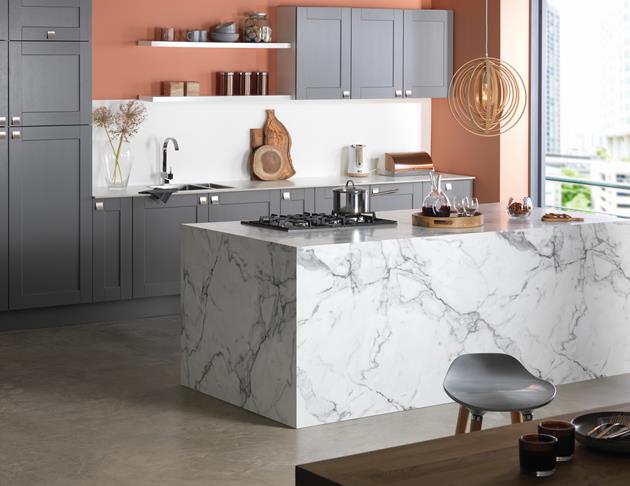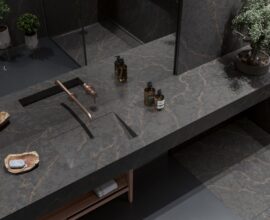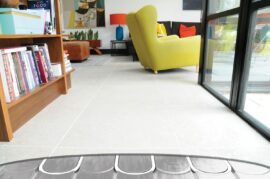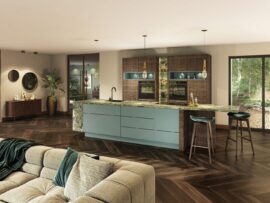UK kitchens are shrinking in size, yet growing in importance
- 30% of Brits are frustrated by lack of storage space in their kitchens making it by far the greatest annoyance, new research reveals
- 55% of the UK population consider the looks and functionality of a kitchen as equally important
- Our kitchens are catering for more uses than ever before, yet with less and less space
- When asked about the role of the kitchen in their lives, generational differences between respondents outstrip differences along gender lines
The results are in from a new survey commissioned by Formica Group into kitchen design and the role of the kitchen in our busy lives. It reveals that more than ever, the kitchen is the multifunctional hub of the home; a finding at odds with the fact that kitchens are actually getting smaller.
2,000 UK homeowners and renters were questioned on what they like and dislike about their current kitchens, what they primarily use them for and where they source design inspiration from. Consumers stated time and time again lack of space was a key grievance in one way or another. With UK homes getting smaller, the problem will persist.
No room, no room!
Different variations of the same problem – lack of space – were identified as the biggest frustration for homeowners. Asked about what annoys them about their kitchens, respondents offered complaints such as ‘far too small’, ‘no room for table and chairs’, and ‘if more than one person in it, we get in each other’s way’.
Nearly a third of the respondents were frustrated by a shortage of storage space, making it the biggest gripe among all age brackets. A quarter complained about not having enough food preparation area and 13% said their kitchens were not designed to maximise space. Dated style was the biggest bugbear for 21%. Broken down by age group, the figures show these problems are the biggest among young people, undoubtedly due to typically lower average incomes and the tendency for co-living. For example, whilst 55% of 18-24 year-olds said they were shy of enough cupboards, only 23% of the over-55s agreed.

Multiple functions, ever-decreasing floor space
Kitchen floor space in the UK peaked in the 1960s at 15.37sqm and now averages at just 12.61sqm. With growing populations, rising prices and increasing demand for space, particularly in urban areas, we really are feeling the squeeze. And we’re having to settle for less than our continental friends, with UK homes being the smallest in Europe (Cambridge Uni).
From the results, it is clear today’s kitchen plays a role beyond simply being the space for cooking and eating, especially among younger generations. 72% of 18-24 year olds and 65% of 25-34 year olds reported cooking as the main activity they usually used their kitchens for, compared to 90% of 45-54 year olds and 96% of those over 55.
Significant numbers of younger respondents (27% of 18-24 year olds and 32% of 25-34 year olds) listed entertaining guests and spending time with family as other important uses of the space, yet only 14% of the over-55s agreed.
Kitchens are also increasingly used for work/studying, by 17% of 25-34 year-olds but only 7% of those over 55. Other activities people report using the space for include listening to music/radio and doing the laundry and cleaning.
There was little discrepancy between the genders regarding the primary use of the kitchen. Of 1,131 female and 869 male respondents, 91% of women and 88% of men reported using their kitchens mostly for cooking, with eating (41% of women, 37% of men), entertaining guests (23% of women, 13% of men) and spending time with family (27% of women, 15% of men) as secondary functions.

Aesthetics vs. functionality
Although people rated the look and feel as highly important, no particular style towers over others in popularity. Modern/mid-century emerges as the winner at 23%, followed by country/farmhouse/shaker, preferred by 18%. Contemporary style came in third with 12%. A fifth had no preference for a specific style at all.
Kitchen updates most commonly happen in conjunction with a house move or extension, or as the unfortunate consequence of flood or mould damage.
Peter Rush, President and CEO Formica Group Europe, comments: “The kitchen is the heart of the home and this is clear evidence that its importance in our lives is growing.
“The lack of space in our homes is part of a much bigger problem, specifically the size of UK homes getting smaller. While finding solutions to this may take time, there are ways to address this problem immediately. By making small updates, such as including smart appliances and reorganising storage space, you can personalise your kitchen to meet the demands of your daily life.”

To address these generational trends and multi-functional kitchen usages, Formica worktops have designed new solutions and have come a long way from their well known traditional patterns of the 50s and 60s, for example, the recent development of Formica Infiniti® Worktops. Infiniti is manufactured with an anti-fingerprint, durable and abrasion resistant surface to cater for the demanding requirements of entertainment. Aria™ is another true innovation from Formica which moves away from the traditional laminate worktop and closer to the look of natural materials but without the complex installation and expense. Aria is a solid surface product that provides a thin and lasting worktop application which taps into the trend and desire to have a slimline, minimal and natural looking worktop.
For a kitchen refurbishment, incorporating a breakfast bar or simply modernising a kitchen with a new material, colour or surface can be easily achieved with one of our four worktop brands adaptable to any style, generation or requirement.






